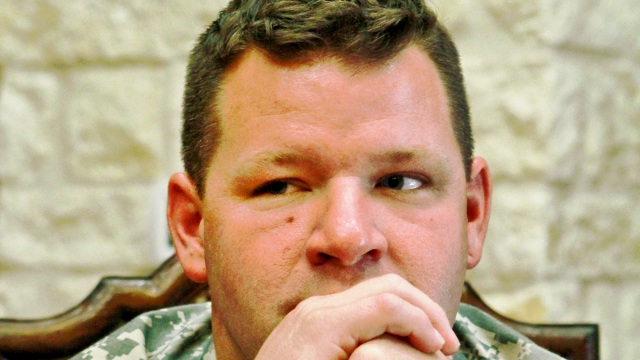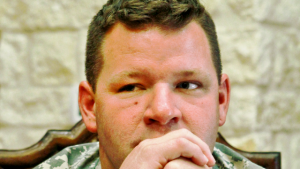Can Meditation Ease PTSD in Combat Vets?

Can Meditation Ease PTSD in Combat Vets?

Among veterans, mental disorders such as post-traumatic stress disorder are epidemic. The Department of Veterans Affairs estimates that one in every four Iraq or Afghanistan vets is suffering from PTSD. It’s one reason suicide is now the leading cause of death among active-duty soldiers.
This crisis has led the VA to explore treatments that would have been considered decidedly from-the-fringes a generation ago. Some of that work is taking place at the Menlo Park division of the VA Palo Alto Medical Center.
"My little safe zone"
John Montgomery is a Vietnam vet with a bushy gray mustache and a tattoo of a scorpion on each forearm. During his time here in the residential PTSD program, he’s been thinking a lot about his life before the war.
“We were dirt farmer kids,” he tells me. “It was the summer of 1957. We were irrigating 80 acres of cotton. My brother was yelling off in the distance and I was just laying back on a haystack…”
Montgomery trails off for a moment, lost in the memory.
“Yeah, that's my little safe zone,” he says.
But when he talks about Vietnam and what he saw there, something in his voice changes, ramps up.
The image he can’t shake – even now, nearly four decades after his return – is of Vietnamese children trying to kill him.
“Our society teaches us to go to school, live with our families and stuff, not to blow somebody else up," he says, as his voice grows louder. "They were after you, you know?”
Today, after what he calls decades of failed relationships and self-abuse, Montgomery is finally getting help for PTSD, a diagnosis he hadn’t even heard of until a few years ago.
Part of his treatment is a twice-weekly guided meditation session.
On a recent afternoon, five men settle into armchairs arranged in a circle. One younger vet in board shorts and flip flops lies down on the floor. Two of the vets served in Vietnam; three younger men served in Iraq. A couple of therapy dogs, golden retrievers named Eldridge and Elaine, settle at their owners’ feet.
Leah Weiss -- a meditation trainer from Stanford’s Center for Compassion and Altruism Research and Education -- begins to lead. “Let’s start with three deep cleansing breaths,” she tells the men.
An old approach, revisited
What’s taking place in this room has been happening on a small scale for decades, says Stephen Xenakis. He’s a retired brigadier general who formerly oversaw the army’s medical system.
In the 1970s, Xenakis worked as a psychiatrist with Vietnam vets at the former Letterman Army Medical Center, in San Francisco’s Presidio. He says meditation was one of several Eastern-inspired treatments he and others were experimenting with.
Even back then, he says, it was clear that meditation could help calm the nervous systems of not just veterans, but prisoners and people suffering from trauma.
But getting the VA to integrate meditation into its standard treatment was tough, especially after the late 1980s, when drugs like Prozac came on the scene. The drugs were easy to study and prescribe, cheap to administer. For a lot of patients, they were very effective.
“I think in many ways,” he says,” these other options that we had learned were helpful back in the ‘70s kind of fell off to the wayside”.
In recent years, it’s become clear that drugs are no panacea. Side effects are common. And for about half of PTSD patients, the drugs don’t work at all. A recent report from the Institute of Medicine concluded that "the evidence is inadequate" to demonstrate that SSRIs, like Prozac, are generally effective in treating PTSD.
Those limitations have renewed interest in other approaches, such as meditation.
What meditation may do to the brain
Back in the TV room at the Menlo Park VA, Weiss’s voice is calm, almost hypnotic. She tells the men to “bring to mind a stranger, maybe someone you pass by when you’re commuting.”
“Consider,” she instructs them, “that just like me, this person has had ups and downs in his or her life. Just like me, this person has had goals and dreams. Just like me, this person knows what it’s like to be disappointed, or afraid.”
This particular meditation -– it’s called “compassion meditation” -- aims at a specific and widely held hypothesis about what is happening in the brain of someone like John Montgomery, the Vietnam vet.
The idea is that in combat, a switch -- a fight-or-flight survival mode located in a part of the brain called the amygdala -- has been turned on, and become essentially stuck. Meanwhile, another part, the frontal cortex, takes the backseat. And that’s critical. Because this part of the brain helps us relate to other people.
“The frontal cortex,” says Stephen Xenakis, “is what allows us to have relationships and families, what gives us a sense that there are rules of society and morality. It's part of what is different about our brains from even other primates, and clearly other mammals."
Whether or not this kind of meditation is effective in treating PTSD is, from a scientific standpoint, still unknown. Studies have shown that repeated sessions can increase "positive affect" and "social connectedness," both of which are deficient in PTSD patients, according to a 2012 meta-analysis on the efficacy of different kinds of meditation in treating PTSD.
Meditation in general, wrote the authors, "holds some promise" as a treatment for PTSD.
Advice from an older veteran
After about 20 minutes, Weiss asks the men to open their eyes and to reflect on what the meditation made them feel.
Most of these men have been taking part in these sessions for a couple months now. They’ve been listening to CDs with Weiss’s voice back in their rooms. They say they feel calmer, more compassionate to other people.
But one of them, Esteban Brojas, is newer to this. Brojas served during the Iraq invasion in 2003. In some ways, he says, it’s like he’s still there.
Coming back to civilian life has been “a culture shock,” he says. “You’re still with that adrenaline; you’re still hyper-vigilant.”
Brojas’s wife gave birth to their daughter while he was in Iraq. When he came back, he didn’t know how to hold her. “After taking someone's life? It’s hard,” he says.
As he speaks, Brojas’s voice starts to tremble and speed up. He rubs his hands together quickly as he rocks back and forth in his armchair.
“After the fact that you're going into a building and there's a grenade being popped and there's a woman and a child in there? It's hard. To come home and hold your daughter in your hands?”
Doreen, the therapist steps in. “I would say…” she begins, tentatively.
But it's John Montgomery, the Vietnam vet across the room, who knows what to do.
“You're not there,” he tells Brojas, firmly. “You're right here. You're not there right now. You’re in it. It'll take time. It's like a wave coming. It’ll subside.”
Montgomery’s doing something he thought he had forgotten how to do: feel compassion. In a few weeks, he’ll leave this program and go back to his family – a different man, he hopes, than he was when he came here.
